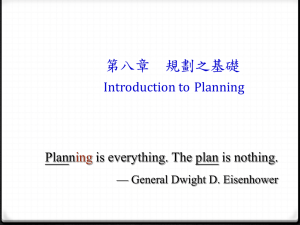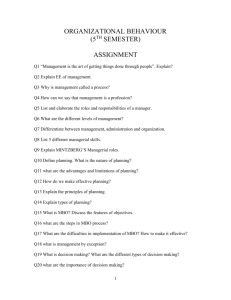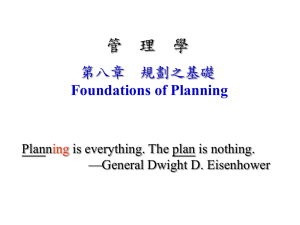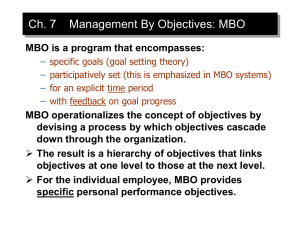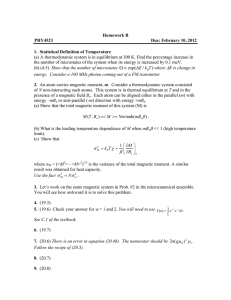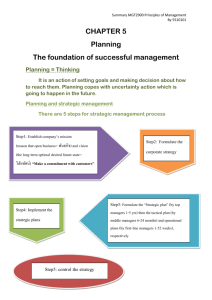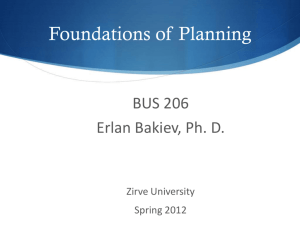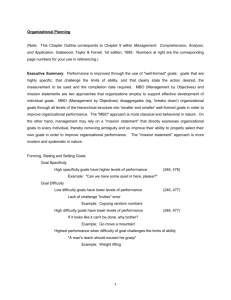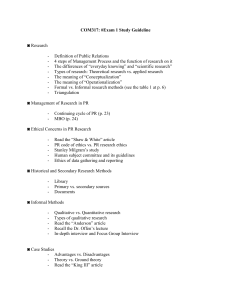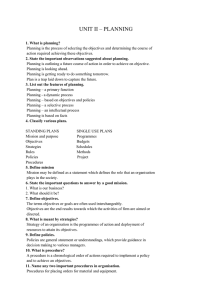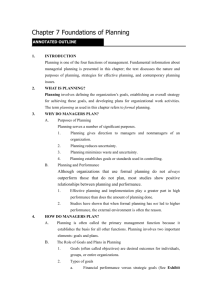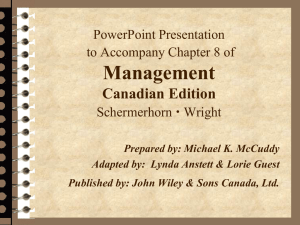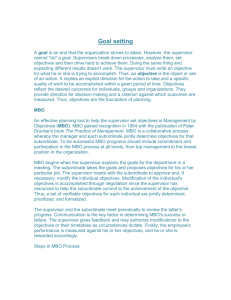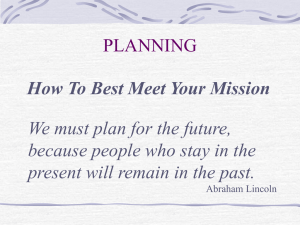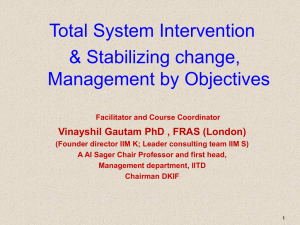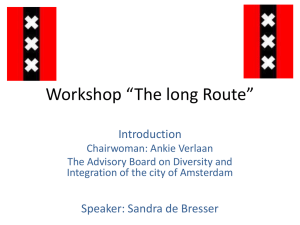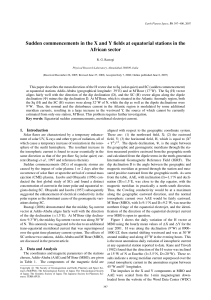Planning - Future Academy
advertisement
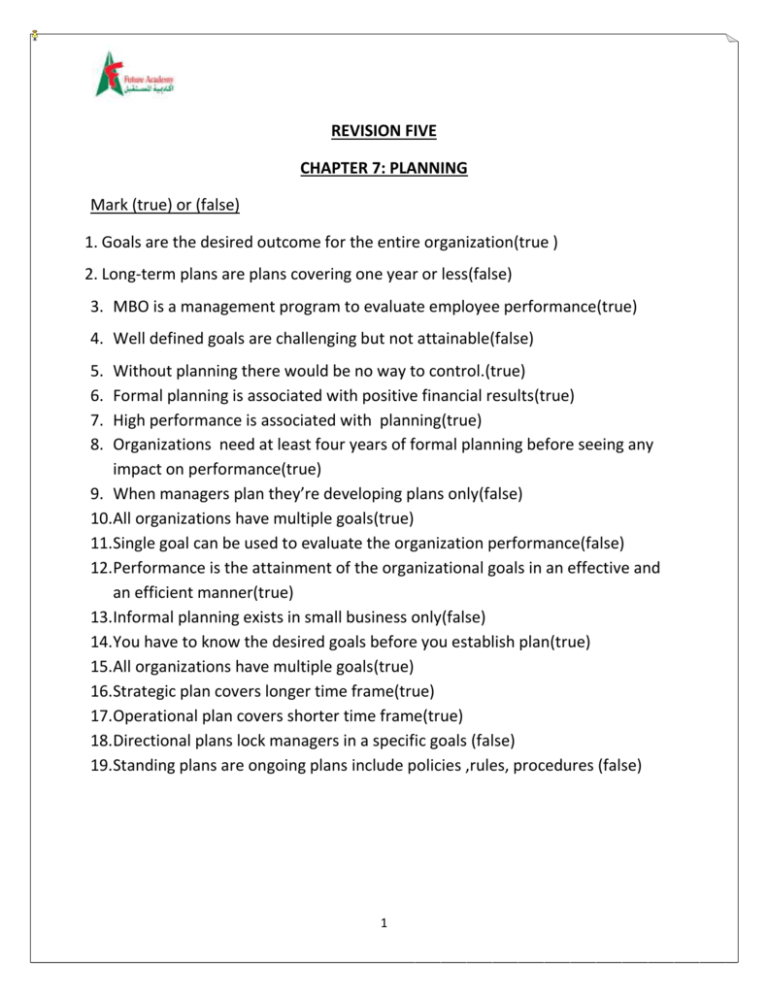
REVISION FIVE CHAPTER 7: PLANNING Mark (true) or (false) 1. Goals are the desired outcome for the entire organization(true ) 2. Long-term plans are plans covering one year or less(false) 3. MBO is a management program to evaluate employee performance(true) 4. Well defined goals are challenging but not attainable(false) 5. 6. 7. 8. Without planning there would be no way to control.(true) Formal planning is associated with positive financial results(true) High performance is associated with planning(true) Organizations need at least four years of formal planning before seeing any impact on performance(true) 9. When managers plan they’re developing plans only(false) 10.All organizations have multiple goals(true) 11.Single goal can be used to evaluate the organization performance(false) 12.Performance is the attainment of the organizational goals in an effective and an efficient manner(true) 13.Informal planning exists in small business only(false) 14.You have to know the desired goals before you establish plan(true) 15.All organizations have multiple goals(true) 16.Strategic plan covers longer time frame(true) 17.Operational plan covers shorter time frame(true) 18.Directional plans lock managers in a specific goals (false) 19.Standing plans are ongoing plans include policies ,rules, procedures (false) 1 Planning 1. What is planning? A primary functional managerial activity that involves:a. Defining the organizational goals. b. Setting an overall strategy for achieving those goals. c. Developing plans for the future organizational activities. 2. Planning can be either formal or informal (explain) Informal planning: a. Nothing is written down b. No sharing of goals with others in the organization c. Goals are general not specific d. Lack continuity Formal planning: a. Written goals b. Goals are shared with others in the organization c. Goals are specific d. Managers define how to reach goals 3. Why do managers plan? a. Setting goals b. Setting strategies to achieve these goals c. Developing plans 4. What are the purposes of planning? a. Planning provides direction to managers and nonmanagers b. Reducing uncertainty by forcing managers to look ahead c. Minimizing waste and redundancy d. Establishes standard used in controlling 5. What is performance? Performance is to attain the organizational goals in an efficient and effective manner 2 6. What are the elements of planning? Goals and plans: a. Goals are the desired target or outcome before establishing plans b. Plans are the outline how goals are going to be met 7. What are the different types of goals? a. Strategic goals: Related to the organization performance b. Financial goals: Related to the financial performance c. Real goals : Goals that an organization pursues by the actions of its members d. Stated goals : Official statement of what an organization says or wants 8. What are the different types of plans? a. Strategic plan Apply to the entire organization Establish the organization’s overall goals Seek to position the organization in terms of its environment Cover extended periods of time b. Operational plan Specify the details of how the overall goals are to be achieved Cover short time period c. Long term plan Plans with time frames extending beyond three years d. Short term plan Plans with time frame on one year or less e. Directional plan Flexible plans that set out general guidelines ,provide focus ,yet allow discretion in implementation f. Specific plan Plans that are clearly defined and leave no room for interpretation g. Single use plan A one-time plan specifically designed to meet the need of a unique situation h. Standing plan Ongoing plans that provide guidance for activities performed repeatedly 3 9. What is the difference between strategic and operational plan? Strategic plan covers longer time frame-broader view of organization-formulation of goals Operational plan covers shorter time frame-defines ways to achieve goals 10. What are the different approaches of setting goals? Traditional goal setting Broad goals are set at the top of the organization Goals are then broken into sub-goals for each organizational level Assumes that top management knows best because they can see the “big picture” Goals are intended to direct, guide, and constrain from above. Goals lose clarity and focus as lower-level managers attempt to interpret and define the goals for their areas of responsibility. Management by objectives (MBO) 11. Write short note about MBO Specific performance goals are jointly determined by employees and managers. Progress toward accomplishing goals is periodically reviewed. Rewards are allocated on the basis of progress towards the goals. Reason for MBO Success Top management commitment and involvement. Potential problems with MBO programs Not as effective in dynamic environments that require constant resetting of goals. Overemphasis on individual accomplishment may create problems with teamwork. 12. What are the elements of MBO? Goal specificity Participative decision making An explicit performance /evaluation period feedback 4 13. What are the characteristic of well designed goals? 1. Written in terms of outcome not actions. 2. Can be measured 3. Clear with a time frame 4. Written down 5. Challenging but attainable (not too easy ) 6. Communicated to all necessary organization members. 14. What steps should managers follow in setting goals? 1. Review the organization’s mission Mission: is the purpose of an organization 2. Evaluate available resources 3. Determine the goals individually 4. Write down goals and communicate them to all who need to know 5. Review results to see if goals are being 5 FACTS 1. Planning is concerned with both ends. 2. Planning can be either formal or informal 3. Informal planning exists in both small and large businesses as well. 4. Without planning department and individuals might work at cross purposes 5. When both means and ends are made clear through planning inefficiencies can be corrected and eliminated. 6. When managers plan they develop goals and plans. 7. When managers control they see how plans have been carried out and the goals met. 8. Goals are the foundation of planning. 9. In reality all the organizations have multiple goals. 10. No single goal can be used to evaluate whether the organization is successful or not. 11. If managers emphasize one goal, other goals will be ignored. 12. Using single objective can result in unethical practices. 13. Organizations stated goals are often quite irrelevant to what actually goes on. 14. When uncertainty is high managers must be flexible to respond to unexpected changes so directional plans are preferable. 15. Single- use plan is in contrast with standing plan 16. MBO may not be effective in times of dynamic environmental change. 17. There are problems with MBO programs. 18. Goals are not all created equal. 6 19. The desired end result is the most important element of any goal so it should be written to reflect this. 20. There should be some specific ways to measure quality of the product. 21. Goals without time frame make an organization less flexible. 22. Goals that are too easy to accomplish are not motivating. 23. Goals that are not attainable are not motivating. 24. The process of writing goals down forces people to think of them 25. Communicating goals make people aware of the goals to make sure that they are on the same page. 26. Goal should reflect the intent of the organization mission. 27. Goals should be realistic. 28. Goals should be suitable with the organizational mission. 29. Goals should be measureable, specific, has time frame for accomplishment. 30. If goals are not be met make changes to the goals as needed. 31. Once goals have been established, written and communicated manager can develop a plan. 32. Goals are not all created equal 33. Some goals are better than others. 34. Performance should be evaluated. 35. Goals lose clarity and unity as they go down from top to the lower level. 7 8
